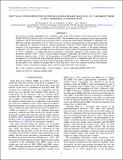SWIFT X-RAY TELESCOPE STUDY OF THE BLACK HOLE BINARY MAXI J1659–152: VARIABILITY FROM A TWO COMPONENT ACCRETION FLOW
Author(s)
Kalamkar, M.; Klis, M. van der; Heil, L.; Homan, Jeroen
DownloadKalamkar-2015-Swift X-ray telescop.pdf (842.2Kb)
PUBLISHER_POLICY
Publisher Policy
Article is made available in accordance with the publisher's policy and may be subject to US copyright law. Please refer to the publisher's site for terms of use.
Terms of use
Metadata
Show full item recordAbstract
We present an energy dependent X-ray variability study of the 2010 outburst of the black hole X-ray binary MAXI J1659–152 with the Swift X-ray Telescope (XRT). The broadband noise components and the quasi-periodic oscillations (QPO) observed in the power spectra show a strong and varied energy dependence. Combining Swift XRT data with data from the Rossi X-ray Timing Explorer, we report, for the first time, an rms spectrum (fractional rms amplitude as a function of energy) of these components in the 0.5–30 keV energy range. We find that the strength of the low-frequency component (<0.1 Hz) decreases with energy, contrary to the higher frequency components (>0.1 Hz) whose strengths increase with energy. In the context of the propagating fluctuations model for X-ray variability, we suggest that the low-frequency component originates in the accretion disk (which dominates emission below ~2 keV) and the higher frequency components are formed in the hot flow (which dominates emission above ~2 keV). As the properties of the QPO suggest that it may have a different driving mechanism, we investigate the Lense–Thirring precession of the hot flow as a candidate model. We also report on the QPO coherence evolution for the first time in the energy band below 2 keV. While there are strong indications that the QPO is less coherent at energies below 2 keV than above 2 keV, the coherence increases with intensity similar to what is observed at energies above 2 keV in other black hole X-ray binaries.
Date issued
2015-07Department
MIT Kavli Institute for Astrophysics and Space ResearchJournal
The Astrophysical Journal
Publisher
IOP Publishing
Citation
Kalamkar, M., M. van der Klis, L. Heil, and J. Homan. “SWIFT X-RAY TELESCOPE STUDY OF THE BLACK HOLE BINARY MAXI J1659–152: VARIABILITY FROM A TWO COMPONENT ACCRETION FLOW.” The Astrophysical Journal 808, no. 2 (July 28, 2015): 144. © 2015 The American Astronomical Society
Version: Final published version
ISSN
1538-4357
0004-637X